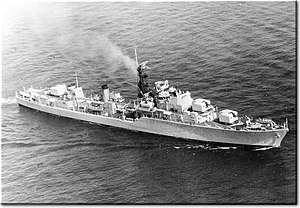
HMS Hermes was a British aircraft carrier built for the Royal Navy and was the world's first ship to be designed as an aircraft carrier, although the Imperial Japanese Navy's Hōshō was the first to be commissioned. The ship's construction began during the First World War, but she was not completed until after the end of the war, having been delayed by multiple changes in her design after she was laid down. After she was launched, the Armstrong Whitworth shipyard which built her closed, and her fitting out was suspended. Most of the changes made were to optimise her design, in light of the results of experiments with operational carriers.
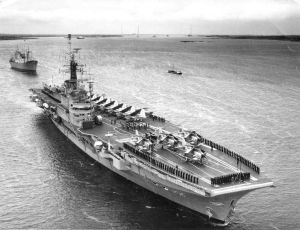
HMS Centaur was the first of the four Centaur-class light fleet carriers of the Royal Navy. She was the only ship of her class to be completed with the original design configuration of a straight axial flight deck, rather than the newly invented angled flight decks of her three later sister ships. She was laid down in 1944 in Belfast, with the contract being awarded to Harland and Wolff, but not launched until 22 April 1947 due to delays relating to the end of the war. She was commissioned on 1 September 1953, almost nine years from when she was laid down in 1944.

HMAS Duchess was a Daring-class destroyer that served in the Royal Navy as HMS Duchess from 1952 to 1964, and in the Royal Australian Navy (RAN) from 1964 to 1980. She was laid down by John I. Thornycroft and Company, and commissioned into the Royal Navy in 1952.

HMS Attacker (D02) was an American-built escort carrier that served with the Royal Navy during the Second World War.

The sixth HMS Bulwark of the Royal Navy was a 22,000 ton Centaur-class light fleet aircraft carrier. Initially commissioned as a light aircraft carrier in 1954, the ship was converted into a commando carrier in 1958 and recommissioned as such in 1960. Bulwark remained in this capacity until 1979 following failed efforts to sell the ship, Bulwark re-entered service as an anti-submarine warfare carrier and remained as such until being decommissioned in 1981. The ship was scrapped in 1984.

HMS Birmingham was a Type 42 destroyer laid down by Cammell Laird and Company, Limited, at Birkenhead on 28 March 1972, launched on 30 July 1973 by Lady Empson, wife of Sir Derek Empson and commissioned on 3 December 1976. She was named for the city of Birmingham, England.

HMS Morecambe Bay was a Bay-class anti-aircraft frigate of the British Royal Navy, named after Morecambe Bay on the north western coast of England. In commission from 1949 until 1956, she saw active service in the Korean War, and was sold to Portugal in 1961 to serve as NRP Dom Francisco de Almeida until 1970.
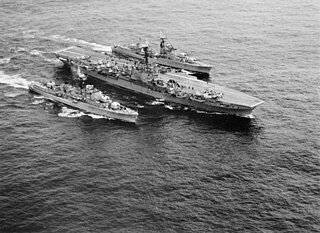
HMAS Voyager was a Daring-class destroyer of the Royal Australian Navy (RAN), that was lost in a collision in 1964.

HMS Duncan is the sixth and last of the Type 45 or Daring-class air-defence destroyers built for the Royal Navy and launched in 2010. Duncan is named after Adam Duncan, 1st Viscount Duncan, who defeated the Dutch fleet at the Battle of Camperdown on 11 October 1797. The destroyer has served in the Mediterranean, Black, and Caribbean Seas, and in 2019 was deployed to the Persian Gulf in response to increased tensions with Iran in the region.
HMS St Austell Bay was a Bay-class anti-aircraft frigate of the British Royal Navy, named after St Austell Bay on the south coast of Cornwall. In commission from 1945 until 1956, she served in the Mediterranean Fleet and on the America and West Indies Squadron.
HMS St Brides Bay was a Bay-class anti-aircraft frigate of the British Royal Navy, named for St Brides Bay in Pembrokeshire. In commission from 1945 to 1961, she served in the Mediterranean and Eastern Fleets, seeing active service in the Korean War.

HMS Veryan Bay was a Bay-class anti-aircraft frigate of the British Royal Navy, named after Veryan Bay on the south coast of Cornwall. In commission from 1945 until 1957, she saw service in the Pacific, Mediterranean, and Home Fleets, in the West Indies and in the South Atlantic.

HMS Whitesand Bay was a Bay-class anti-aircraft frigate of the British Royal Navy, named for Whitesand Bay in Cornwall. In commission from 1945 to 1954, she served in the Pacific, Mediterranean, West Indies and Far East Fleets, seeing active service in the Korean War.
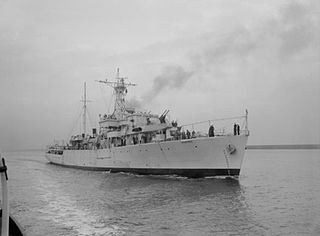
HMS Surprise was a Bay-class anti-aircraft frigate of the British Royal Navy. In commission from 1946 to 1965, she served in the Mediterranean Fleet as a Despatch Vessel for the Commander-in-Chief. Although principally employed for the use as a yacht by the CinC, Surprise was also deployed in its operational role as an anti-aircraft frigate and was allocated to the Haifa Patrol for a brief period in 1948. The archaic term "Despatch Vessel" was replaced by "Flag Frigate" in 1961.

HMS Loch Fyne was a Loch-class frigate of the British Royal Navy, built by the Burntisland Shipbuilding Company Ltd, Burntisland, Fife, Scotland, and named after Loch Fyne in Scotland. The ship was launched in 1944, and served at the end of World War II. Recommissioned in 1951, she served in the Persian Gulf and was scrapped in 1970.

HMNZS Rotoiti (F625) was a Loch-class frigate of the Royal New Zealand Navy (RNZN), which had formerly served in the British Royal Navy as HMS Loch Katrine at the end of World War II.

HMNZS Hawea (F422), formerly HMS Loch Eck (K422), was one of six Loch-class frigates that served in both the Royal Navy (RN) and the Royal New Zealand Navy (RNZN). The ship was laid down by Smiths Dock on 25 October 1943, launched on 25 April 1944 and commissioned into the Royal Navy as HMS Loch Eck on 7 November 1944.

HMS Arrow was an A-class destroyer of the Royal Navy, built by Vickers-Armstrongs at their Barrow-in-Furness between 1928 and 1930, being launched on 22 August 1929. Arrow served in the Mediterranean Fleet in the 1930s, rescuing refugees and taking part in neutrality patrols during the Spanish Civil War.
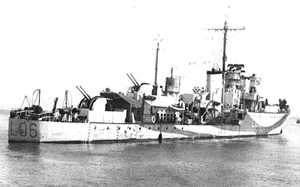
HMS Avon Vale(pennant number L06) was an escort destroyer of the Hunt Type II class. The Royal Navy ordered Avon Vale's construction three days after the outbreak of the Second World War. John Brown Shipbuilding & Engineering Company Ltd laid down her keel at their Clydebank yard on 12 February 1940, as Admiralty Job Number J1569. After a successful Warship Week national savings campaign in February 1942, Avon Vale was adopted by the civil community of Trowbridge, Wiltshire.
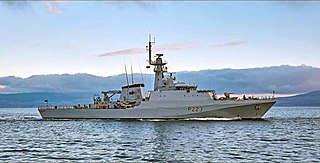
HMS Medway is a Batch 2 River-class offshore patrol vessel for the Royal Navy. Named after the River Medway in Kent, she was the second Batch 2 River-class vessel to be commissioned and is assigned long-term as Royal Navy guardship in the Caribbean.
